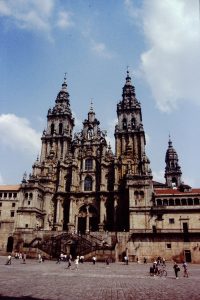Pilgrimage was significant to medieval religious life, and I have spoken of it in several of the Lady Apollonia West Country Mysteries. There were many pilgrimage destinations in England as well as Europe and the Mediterranean world beyond. Canterbury was the most famous pilgrimage church in England because of the martyrdom and sainthood of Archbishop Thomas Becket who was killed in Canterbury Cathedral in 1170 during the reign of King Henry II. Fourteenth century pilgrims going to Canterbury from Southwark have been immortalised by Geoffrey Chaucer in his Canterbury Tales.
Cathedrals and monastic churches throughout the Christian world used the remains of various saints and other relics to attract pilgrims. For some, the ultimate pilgrimage was to Jerusalem and the Holy Land. Rome was another important pilgrimage site for medieval Christians. Many pilgrims crossed Europe to Spain to visit Santiago de Compostela. There, they wished to see the shrine of Christ’s disciple, Saint James the Great, which is pictured below.
Phyllis of Bath is a character in my 2nd novel, Plague of a Green Man, set in Exeter in 1380, obviously based on Chaucer’s Wife of Bath. Phyllis announces proudly that she has travelled to all of the pilgrimage sites mentioned above.
Martin Harlech, an English pilgrim from Cirencester, opens Templar’s Prophecy, my 4th novel, by entering the Nubian city of Banganarti in Africa to seek healing from his personal affliction in the Church of the Archangel Raphael. Now, merely ruins explored by archaeologists in the 21st century, Banganarti was the most important healing site in the Kingdom of Makuria. My character, Martin, went there in 1350, a few years before this important Christian pilgrimage site was overrun by Islam. In Templar’s Prophecy, it is Martin Harlech’s granddaughter who plays a role in my story.
Robert Kenwood, an English pilgrim from Worcester, introduces my forthcoming novel, King Richard’s Sword, by returning to his home town from a pilgrimage to Santiago de Compostela. This fictional character was inspired by the remains of a real Worcester pilgrim, a medieval skeleton discovered along with his pilgrim’s walking stick within Worcester Cathedral a few years ago. My character, Robert, is a wealthy merchant of Worcester who, with his family, become good friends of the Lady Apollonia of Aust.
Monasteries, great churches, cathedrals, even parish churches of the 14th century were built to display relics and accommodate pilgrims seeking the intercession of saints. Yet, in so many ways, pilgrimage was also an international tourist industry of that time. My heroine, the Lady Apollonia never goes on a pilgrimage herself, but to be true to the period, some aspects of pilgrimage must be part my stories.
Tags: Chaucer's England, historical fiction, medieval mysteries, pilgrimage